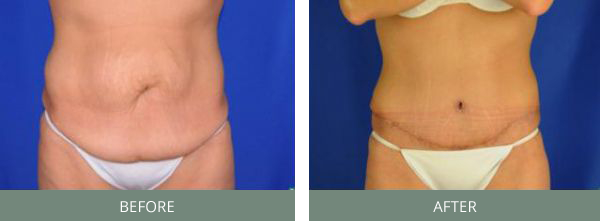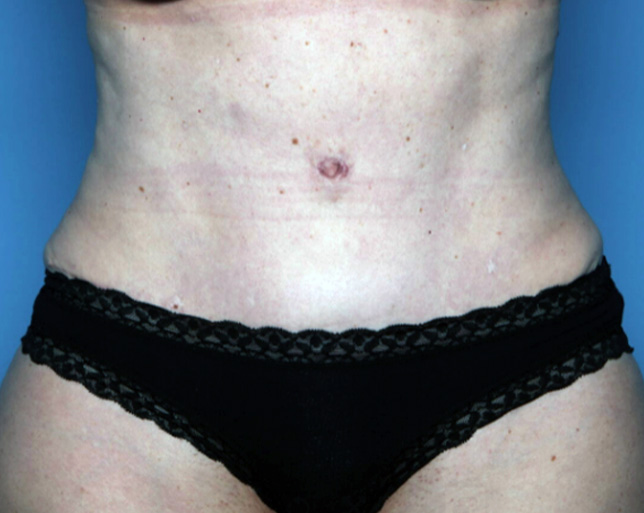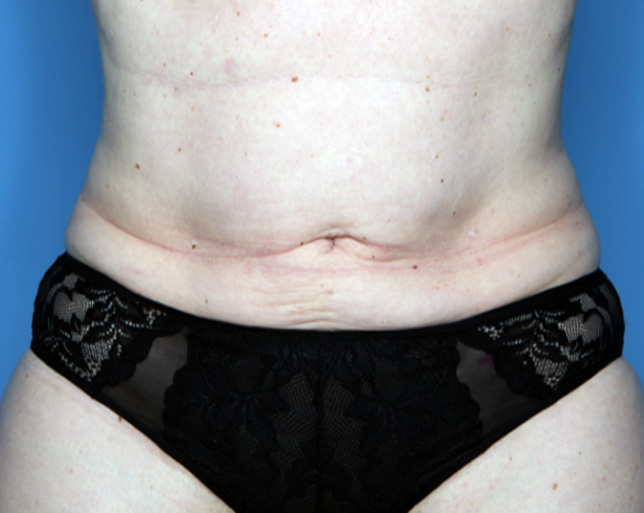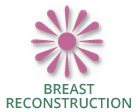EYELID SURGERY
Blepharoplasty Can Address the Effects of Aging on Both Upper and Lower Lids in St. Louis
West County Plastic Surgeons performs blepharoplasty, more commonly known as eyelid surgery, for St. Louis patients. The procedure can address age-related changes to the upper lid, the lower lid, or both. Upper eyelid surgery involves removing excess skin, muscle, and fat that can make the eye look hooded, tired, heavy, or droopy. Lower eyelid surgery involves removing excess skin, muscle and fat deposits that can create bags, puffiness, dark circles, wrinkles, or an overall tired appearance. It can also tighten and reposition the eyelid or create a smooth, well-contoured transition between the bottom eyelid and the midface.
Board-certified plastic surgeons Dr. Terry Myckatyn and Dr. Marissa Tenenbaum specialize in eyelid surgery, having performed thousands of successful blepharoplasty procedures. As Washington University School of Medicine faculty members, they stay current on the most advanced techniques and technologies in face procedures and a range of other plastic surgery options. Drs. Myckatyn and Tenenbaum have not only training and experience that lead to technical mastery, but also warm and approachable personalities that lead to good communication. At West County Plastic Surgeons, we pride ourselves on being good listeners because we understand that only when we fully comprehend your concerns can we meet your expectations and help you achieve beautiful, satisfying, safe results.
To speak with one of our plastic surgeons about eyelid surgery in St. Louis, contact our office by phoning (314) 996-8800 or requesting your consultation online today.
Upper & Lower Eyelid Incisions
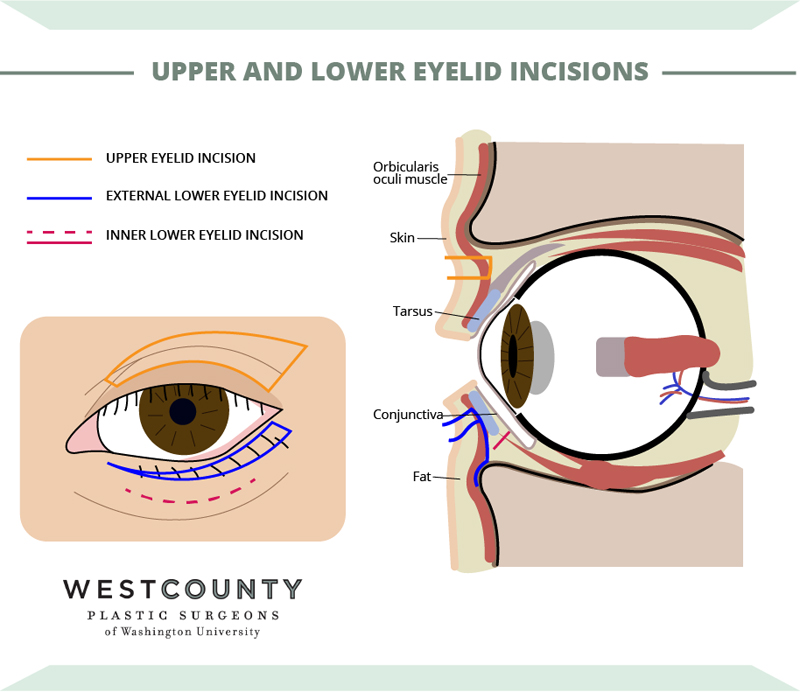
Upper Eyelid Surgery Basics
During upper eyelid surgery, your surgeon places an incision in the eyelid crease so that the scar remains hidden when the eyes are open and extremely faint when they are closed. This procedure rejuvenates the eye area, helping patients look younger, more alert, and well rested. It can also address drooping skin that has begun to intrude from above into a patient's field of vision.
Click here to view a video on upper-eyelid blepharoplasty.
Lower Eyelid Surgery Basics
During this procedure, your surgeon creates a small incision along the lower eyelids, either inside each lid or outside along the lash line, to provide access to the area below each eye. From there, your surgeon will remove and reposition fat deposits, bulging muscle tissue, or excess skin to refresh and rejuvenate your eyes. This eyelid surgery is often combined with fat grafting or fat transfer to the lower eyelid.
Click here to view a video on lower eyelid surgery.
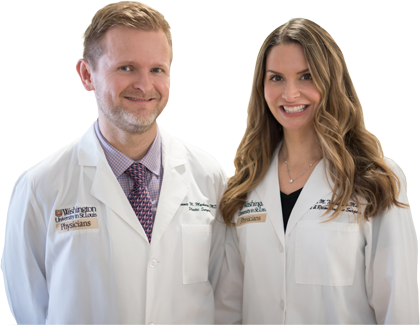
Dr. Terry Myckatyn and
Dr. Marissa Tenenbaum:
Trusted. Experienced. Committed.
What Are My Options for Upper Eyelid Surgery?
For most of our upper eyelid surgery patients, we use a traditional technique, which involves removing excess skin and fat to create a more alert, youthful-looking eye area. However, this is not always the case, and at West County Plastic Surgeons, we customize your procedure to meet your needs. For instance, some patients who have a condition called dermatochalasis, or excess eyelid skin, require a procedure that removes skin only. Others have bulging fat pads along the lid, which can be removed from their discrete fat compartments. Occasionally, a thin strip of muscle called the orbicularis oculi is also removed to reduce bulk in the eyelid.
In some cases, excess skin on the eyelid can lead to straining, causing an individual's eyelids to work harder than normal to remain open. In this case, health insurance often covers upper-eyelid surgery to remove the redundant skin and optimize the field of vision.
Upper Eyelid Surgery: What You Should Know
Anesthesia: Upper blepharoplasty is typically performed with the patient under local anesthesia, which is administered in the office. The procedure can also be performed with the patient under general anesthesia, if requested by the patient or if the surgery is combined with other procedures.
Length of procedure: 30 to 60 minutes.
Estimated recovery time: Upper eyelid surgery patients may return to work after a few days, but should avoid vigorous activities for 1 week. You may have visible sutures in the eyelid for 5 to 6 days. Visible bruising or swelling should resolve within 1 to 2 weeks. To learn how to prepare for this procedure and what to expect afterward, click here to download our patient instructions.
Side effects: Common side effects of upper eyelid surgery include bruising, swelling, a well-hidden scar, and possibly some eye irritation. Click here to download a detailed consent form from the American Society of Plastic Surgeons that lists the risks and benefits of this surgery.
What Are My Options for Lower Eyelid Surgery?
There are two forms of lower eyelid surgery: A transconjunctival blepharoplasty removes fat deposits from the bottom eyelid through a well-hidden incision on the inner surface of the bottom eyelids. To tighten or remove excess eyelid skin, the transconjunctival blepharoplasty can be combined with laser tightening of the bottom eyelid or a second incision through which excess skin is removed.
A subciliary blepharoplasty removes excess skin, muscle, and protruding fat through a well-hidden incision just below the bottom lash line to create a well-contoured transition between the eyelid and cheek. This eyelid surgery can also be combined with fat grafting or fat transfer to the hollowing in the lower eyelid or cheek area.
Lower-Lid Blepharoplasty: What You Should Know
Anesthesia: This procedure is performed with the patient under general anesthesia.
Length of procedure: 60 to 90 minutes.
Estimated recovery time: Patients may return to work after 1 to 2 weeks, but should refrain from exerting themselves for 3 weeks. Bruising and swelling around the eye typically resolves within 1 to 2 weeks. Click here for patient instructions to learn how to prepare for lower eyelid surgery and what to expect following the procedure.
Side effects: Common side effects include bruising and swelling, a camouflaged or obscured scar, and some potential eye irritation. Downward traction of the eyelid may occur in some cases, but usually resolves in days to weeks. Click here to download a detailed consent form from the American Society of Plastic Surgeons, listing the risks and benefits of lower eyelid surgery.
Before-and-after photos of eyelid lifts and brow lifts (forehead lifts): Click here
Before & After
Visit our Photo Gallery to see our patient results.
*Results may vary.
View Patient ResultsProcedures That Complement Eyelid Surgery
Upper eyelid surgery is one of the most effective procedures for improving the overall appearance of the eye area. However, in certain patients, combining upper blepharoplasty with the following procedures produces the most aesthetically pleasing results:
- Droopy eyelid or "ptosis" repair. On occasion, one eyelid droops lower than the other. This condition is known as ptosis, and it has several possible causes. Surgical correction of this condition using a technique called levator advancement may be possible at the time of uppereyelid surgery.
- Brow lift for forehead lift. A brow lift can often be performed at the same time as upper eyelid surgery, or even instead of it, to rejuvenate the upper lid. In addition to treating forehead creases, the brow lift can raise the eyebrows, opening the eye area and creating similar results to upper eyelid surgery. The brow lift can be performed endoscopically, using minimally invasive techniques, through the upper-eyelid incision (transpalpebral brow lift), or through a scalp incision (open brow lift) to achieve the most pleasing results.
Lower eyelid surgery alone can dramatically improve a person's facial appearance. However, in certain patients, optimal results are achieved when lower eyelid surgery is combined with the following procedures:
- Canthopexy or canthoplasty. Lower-lid blepharoplasty can occasionally result in loosening of the eyelid, which causes the lower eyelashes to be out of position and increases exposure of the sclera, or white part of the eyeball. A canthopexy procedure reconstructs and tightens the outer part of that eyelid, or canthus, to improve its position. A canthoplasty procedure reconstructs and tightens the outer part of the lower eyelid to improve its position. Both are commonly performed with a subciliary lower eyelid surgery or other reconstructive procedures to secure the position of the lower lid.
- Mid-face lift. The mid-face, which includes the part of the face below the eyes and above the mouth, can be rejuvenated by extending either the transconjunctival or subciliary lower-lid blepharoplasty procedure.
- Fat grafting or repositioning. Your own fat, sometimes referred to as autologous fat, can be used to fill deep creases, add volume, or create attractive contours in the mid-face. Bulges of fat directly below the eye can be repositioned to smooth mid-face contours, or fat can be harvested from other areas of the body, including thighs or abdomen, and then transferred to the mid-face to fill creases and improve contours. Alternatively, some injectable hyaluronic acid fillers, such as JUVEDERM®, can be used in place of autologous fat for this purpose.
Schedule a consultation today to speak with one of our board-certified plastic surgeons about combining blepharoplasty—upper or lower—with other procedures or treatments to help you achieve your aesthetic goals.
Contact out office to arrange an appointment for eyelid surgery in St. Louis office by phoning (314) 996-8800 or requesting your consultation online.







